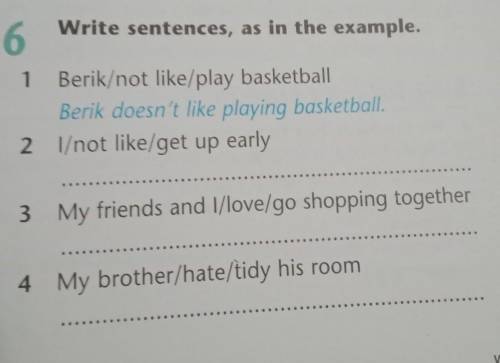Ng TOP 6.
Write sentences, as in the example.
1 Berik/not like/play basketball
Berik doesn't like playing basketball.
2 1/not like/get up early
3 My friends and I/love/go shopping together
4 My brother/hate/tidy his room

Другие вопросы по теме Английский язык
Популярные вопросы
- How different are russian and american teenagers?...
1 - 5/7x=2 целых 1/2 я думаю будет 2/7...
1 - На 2 клумбы посадили 52 куста роз, причём на первую посадили...
2 - Какой из перечисленных городов является столицей государства?...
2 - Числа x и y связаны формулой y= 5*(6x-4) + 27. найдите: а) у,...
1 - Выпишите грамматическую основу из предложения 22...
1 - 1)какие качества царя раскрылись в этой сказке? 2)найди и прочиатй...
3 - Из пункта а в пункт б расстояние между которыми 558 км выехал...
3 - Вгараже 75% всех машин состовляют автобусы а остольное грузовики...
3 - Одно колесо делает 2100 оборотов за 35 минут а другой 980 оборотов...
2
2. i don’t like get up early
3. my friends and me love go to shopping together
4. my brother hate tidies his room
Объяснение: я не знаю правильно ли это
3. My friends and I love going shopping together.
4. My brother hates tidying his room.
To form the sentences, we need to understand the structure and meaning of each sentence. The given sentences provide information about someone's preferences or dislikes towards certain activities.
1. Berik/not like/play basketball
In this sentence, Berik is the subject. We need to add "doesn't" before the verb "like" to make the sentence negative. Then we add the -ing form of the verb "play" to show the activity. The final sentence becomes "Berik doesn't like playing basketball."
2. 1/not like/get up early
In this sentence, "1" is used as a placeholder for the subject, as it is not specified. We need to add "don't" before the verb "like" to make the sentence negative. Then, we use the base form of the verb "get up" to show the activity. The final sentence becomes "I don't like getting up early."
3. My friends and I/love/go shopping together
In this sentence, "My friends and I" is the subject. We can use the verb "love" to show their preference, and the verb "go" to show the activity. To connect the verb "go" with the phrase "shopping together," we add the -ing form of the verb "shopping." The final sentence becomes "My friends and I love going shopping together."
4. My brother/hate/tidy his room
In this sentence, "My brother" is the subject. We can use the verb "hate" to show his strong dislike, and the verb "tidy" to show the activity. The final sentence becomes "My brother hates tidying his room."
By following these steps, we can form accurate and grammatically correct sentences based on the given information.